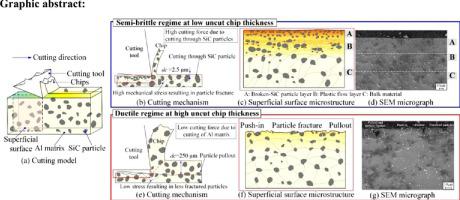当前位置:
X-MOL 学术
›
J. Mater. Process. Tech.
›
论文详情
Our official English website, www.x-mol.net, welcomes your
feedback! (Note: you will need to create a separate account there.)
On understanding the specific cutting mechanisms governing the workpiece surface integrity in metal matrix composites machining
Journal of Materials Processing Technology ( IF 6.7 ) Pub Date : 2021-02-01 , DOI: 10.1016/j.jmatprotec.2020.116875 Xiao Han , Dongdong Xu , Dragos Axinte , Zhirong Liao , Hao Nan Li
Journal of Materials Processing Technology ( IF 6.7 ) Pub Date : 2021-02-01 , DOI: 10.1016/j.jmatprotec.2020.116875 Xiao Han , Dongdong Xu , Dragos Axinte , Zhirong Liao , Hao Nan Li

|
Abstract Machining of metal matrix composites (MMCs) is always challenging due to the mismatch of mechanical and thermal properties between the soft matrix and the abrasive reinforced particles, which causes rapid tool wear and severe surface damage. This paper investigates the effects of cutting regimes on surface integrity in machining of MMCs to understand the (sub) surface damage mechanism induced by thermo-mechanical loads in accordance with the evaluation on particle behaviours and matrix metallurgical transformation. For the first time, it is observed that two different cutting regimes (semi-brittle and ductile cutting) occur in machining of MMCs depending on the feed rate/uncut chip thickness. The machined surface morphology greatly depends on these two cutting regimes wherein various particle removal modes (i.e. push-in, crack and pullout) are generated due to the different cutting mechanisms. The semi-brittle cutting regime tends to happen under low uncut chip thickness and lead to obvious damaged surface morphology (high density of fractured particles), while matrix plastic deformation associated with high cutting temperature and built-up heat is found on the machined surface. Furthermore, the semi-brittle cutting regime further leads to an interesting phenomenon within the superficial surface: (i) a layer of broken SiC particles and (ii) the plastic flow of matrix around the hard particles which act as local barriers. Also, the aggregation of fractured particles and strain hardening of matrix can cause an increased hardness at the near-surface area. An additional cutting experiment on matrix material as a comparison revealed that the brittle fracture of reinforced particles plays a key role in the specific mechanism of MMCs under very low uncut chip thickness, which can cause cutting force increase, flank wear accelerate and the formation of surface damage.
中文翻译:

了解控制金属基复合材料加工中工件表面完整性的特定切削机制
摘要 由于软基体和磨料增强颗粒之间的机械和热性能不匹配,金属基复合材料 (MMC) 的加工一直具有挑战性,这会导致刀具快速磨损和严重的表面损伤。本文研究了切削方式对 MMC 加工中表面完整性的影响,以根据对颗粒行为和基体冶金转变的评估,了解由热机械载荷引起的(亚)表面损伤机制。首次观察到,根据进给率/未切削切屑厚度,在 MMC 的加工中出现两种不同的切削方式(半脆性和韧性切削)。加工表面形态在很大程度上取决于这两种切削方式,其中各种颗粒去除模式(即推入、裂纹和拔出)是由于不同的切割机制而产生的。半脆性切削状态往往发生在低未切削切屑厚度下并导致明显的损坏表面形貌(高密度断裂颗粒),而在加工表面发现与高切削温度和积热相关的基体塑性变形。此外,半脆性切割方式进一步导致表面内的有趣现象:(i)一层破碎的 SiC 颗粒和(ii)作为局部屏障的硬颗粒周围的基体塑性流动。此外,破碎颗粒的聚集和基体的应变硬化会导致近表面区域的硬度增加。
更新日期:2021-02-01
中文翻译:

了解控制金属基复合材料加工中工件表面完整性的特定切削机制
摘要 由于软基体和磨料增强颗粒之间的机械和热性能不匹配,金属基复合材料 (MMC) 的加工一直具有挑战性,这会导致刀具快速磨损和严重的表面损伤。本文研究了切削方式对 MMC 加工中表面完整性的影响,以根据对颗粒行为和基体冶金转变的评估,了解由热机械载荷引起的(亚)表面损伤机制。首次观察到,根据进给率/未切削切屑厚度,在 MMC 的加工中出现两种不同的切削方式(半脆性和韧性切削)。加工表面形态在很大程度上取决于这两种切削方式,其中各种颗粒去除模式(即推入、裂纹和拔出)是由于不同的切割机制而产生的。半脆性切削状态往往发生在低未切削切屑厚度下并导致明显的损坏表面形貌(高密度断裂颗粒),而在加工表面发现与高切削温度和积热相关的基体塑性变形。此外,半脆性切割方式进一步导致表面内的有趣现象:(i)一层破碎的 SiC 颗粒和(ii)作为局部屏障的硬颗粒周围的基体塑性流动。此外,破碎颗粒的聚集和基体的应变硬化会导致近表面区域的硬度增加。











































 京公网安备 11010802027423号
京公网安备 11010802027423号